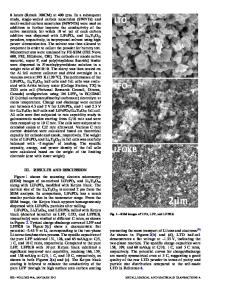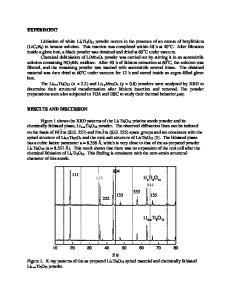Intermediate Phases in Li x FePO 4
- PDF / 718,933 Bytes
- 8 Pages / 612 x 792 pts (letter) Page_size
- 69 Downloads / 299 Views
0972-AA13-02
Intermediate Phases in LixFePO4 Atsuo Yamada1, Shinichi Nishimura1, Hiroshi Koizumi1, Ryoji Kanno1, Shiro Seki2, Yo Kobayashi2, Hajime Miyashiro2, Joanna Dodd3, Rachid Yazami3, and Brent Fultz3 1 Tokyo Institute of Technology, 4259 Nagatsuta, Midori, Yokohama, 226-8502, Japan 2 Central Research Institute of Electric Power Industry, 2-11-1 Iwadokita, Komae, Tokyo, 2018511, Japan 3 California Institute of Technology, 138-78, Pasadena, CA, 91125
ABSTRACT Rietveld analysis for the time of flight powder neutron diffraction profile for LiFePO4 was performed. Tensor elements of the unisotropic thermal factor showed the principal axis of the lithium vibration is toward the face shared vacant tetrahedral space. This is consistent with the theoretical prediction; lithium ions diffuse along curved one-dementional chain along b-axis. Impact of temperature on the phase diagram of LixFePO4 with > 200nm particle size was slight under the unmixing line around 200 C. While the reduction in particle size down to 99%), Fe(II)C2O4.2H2O (Aldrich, 99%), and (NH4)2HPO4 (Wako, >99%). These were thoroughly mixed and reground by conventional planetary milling apparatus for 6 hours, followed by the pre-heat treatment at 300°C for 3 h. The mixture was thoroughly mixed by ball milling again for 1 hour before the final sintering. The olivine LiFePO4 phase was then synthesized by sintering at 700°C for 6 hours in a purified Ar gas flow. For a one-step electrode composite formation, porous carbon (LION, EC) was added with an estimated amount in the final LiFePO4/C composite to be 10 wt%. Chemical oxidation to obtain FePO4 was performed by reacting LiFePO4 with nitronium tetrafluoro-borate NO2BF4, (Aldrich, >95%) in acetonitrile. Lithiated samples of LixFePO4 (0 < x < 1) were prepared by reacting FePO4 with various amounts of LiI (High Purity Chemicals, 99.9%) in acetonitrile. The X-ray diffraction patterns of the powdered samples were obtained with BRUKER AXS D-8 ADVANCE with 2 kW Co- Kα radiation and VÅNTEC-1 PSD counter, followed by Rietveld analysis using TOPAS ver. 2.1 software package. High-temperature measurements were also performed with Anton Parr Chamber TTK 450. Neutron diffraction data were obtained with a time-of-flight (TOF) neutron powder diffractometer, VEGA, at the KENS pulsed spallation neutron source at the National Laboratory for High Energy Accelerator (KEK, Tsukuba, Japan). The specimen (of ca. 5 g) was contained in a cylindrical vanadium cell (radius 5 mm, height 55 mm, thickness 200 µm). Structural parameters were refined using the RIETAN-2001T package. Electrochemical measurements were performed using a 2032 type coin cell. The electrolyte was a 1M solution of LiPF6 in 3:7 ethylene carbonate/diethyl carbonate (EC/DEC) (Mitsubishi Petrochemical, battery grade). The counter electrode was a disk of lithium metal foil (15 mm diameter, 0.30 mm thickness). A polypropylene filter sheet was used as a separator. The working electrode was 10:1 (w/w) cathode composite/polyvinylidene fluoride (PVDF). The mixture was adde
Data Loading...










